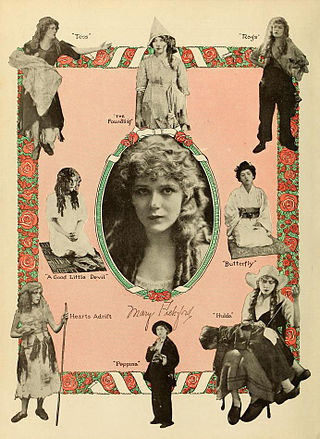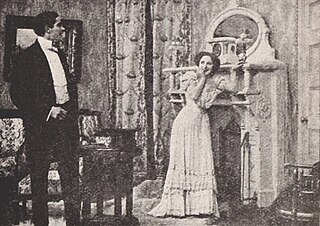
Florence Lawrence was a Canadian-American stage performer and film actress. She is often referred to as the "first movie star", and was long thought to be the first film actor to be named publicly until evidence published in 2019 indicated that the first named film star was French actor Max Linder. At the height of her fame in the 1910s, she was known as the "Biograph Girl" for work as one of the leading ladies in silent films from the Biograph Company. She appeared in almost 300 films for various motion picture companies throughout her career.

Linda Arvidson was an American stage and film actress who became one of America's early motion picture stars while working at Biograph Studios in New York, where none of the company's actors, until 1913, were credited on screen. Along with Florence Lawrence, Marion Leonard, and other female performers there, she was often referred to by theatergoers and in trade publications as simply one of the "Biograph girls". Arvidson began working in the new, rapidly expanding film industry after meeting her future husband D. W. Griffith, who impressed her as an innovative screen director. Their marriage was kept secret for reasons of professional discretion.

Mary Pickford (1892–1979) was a Canadian-American motion picture actress, producer, and writer. During the silent film era she became one of the first great celebrities of the cinema and a popular icon known to the public as "America's Sweetheart".

Herbert Yost was an American actor who in a career that spanned nearly half a century performed predominantly on stage in stock companies and in numerous Broadway productions. Yost also acted in motion pictures, mostly in one-reel silent shorts released by the Biograph Company and Edison Studios between November 1908 and July 1915. By the time he began working in the film industry, Yost already had more than a decade of stage experience in hundreds of dramatic and comedic roles and was widely regarded in the theatre community "as one of the country's finest stock actors". Reportedly, to reduce the risk of tarnishing his reputation as a professional actor by being identified as a screen performer, Yost often billed himself as "Barry O'Moore" while working in films. He was ultimately cast in scores of motion pictures in the early silent era, although with the exceptions of appearing in three more films in the sound era, Yost spent the remaining decades of his career acting in major theatre productions, almost exclusively on Broadway.

A Drunkard's Reformation is a 1909 American drama film directed by D. W. Griffith. Prints of the film survive in the film archive of the Library of Congress. The American Mutoscope and Biograph Company advertised the feature as "The most powerful temperance lecture ever depicted".

Gladys Egan was an early 20th-century American child actress, who between 1907 and 1914 performed professionally in theatre productions as well as in scores of silent films. She began her brief entertainment career appearing on the New York stage as well as in plays presented across the country by traveling companies. By 1908 she also started working in the film industry, where for six years she acted almost exclusively in motion pictures for the Biograph Company of New York. The vast majority of her screen roles during that period were in shorts directed by D. W. Griffith, who cast her in over 90 of his releases. While most of Egan's films were produced by Biograph, she did work for other motion-picture companies between 1911 and 1914, such as the Reliance Film Company and Independent Moving Pictures. By 1916, Egan's acting career appears to have ended, and she no longer was being mentioned in major trade journals or included in published studio personnel directories as a regularly employed actor. Although she may have performed as an extra or in some bit parts after 1914, no available filmographies or entertainment publications from the period cite Egan in any screen or stage role after that year.

Anita Hendrie was an American actress. She appeared in 67 silent motion pictures between 1908 and 1912, in addition to working in stock theater and vaudeville.

The Call of the Wild is a 1908 American short silent Western film directed by D. W. Griffith and produced by the American Mutoscope and Biograph Company. The short, a "one-reeler", stars Charles Inslee, Harry Solter and Florence Lawrence. Its interior scenes were shot at Biograph's studio facilities in New York City, and its exteriors were filmed on location in Coytesville, today one of the oldest communities in Fort Lee, New Jersey.

Edgar Allen Poe [sic] is a 1909 American silent drama film produced by the Biograph Company of New York and directed and co-written by D. W. Griffith. Herbert Yost stars in this short as the 19th-century American writer and poet Edgar Allan Poe, while Linda Arvidson portrays Poe's wife Virginia. When it was released in February 1909 and throughout its theatrical run, the film was consistently identified and advertised with Poe's middle name misspelled in its official title, using an "e" instead of the correct second "a". The short was also originally shipped to theaters on a "split reel", which was a single reel that accommodated more than one film. This 450-foot drama shared its reel with another Biograph short, the 558-foot comedy A Wreath in Time. Prints of both films survive.

A Wreath in Time is a 1909 American silent comedy film written and directed by D. W. Griffith, produced by the Biograph Company of New York City, and co-starring Mack Sennett and Florence Lawrence. At its release in February 1909, the short was distributed to theaters on a "split reel", which was a single reel that accommodated more than one film. A Wreath in Time shared its reel with another Biograph short also directed by Griffith, the drama Edgar Allen Poe [sic]. Original paper rolls of contact prints of both motion pictures, as well as safety-stock copies of the two films, are preserved in the Library of Congress.

Her First Biscuits is a 1909 American silent short comedy film written by Frank E. Woods, directed by D. W. Griffith, and starring John R. Cumpson and Florence Lawrence. At its release in June 1909, the comedy was distributed to theaters on a "split reel", which was a single projection reel that accommodated more than one motion picture. It shared its reel with another Biograph short directed by Griffith, the drama The Faded Lilies. Prints of both films are preserved in the film archive of the Library of Congress.

A Sound Sleeper is a 1909 American comedy film directed by D. W. Griffith and produced by the American Mutoscope and Biograph Company. The short was filmed in one day in the Coytesville borough of Fort Lee, New Jersey, which at the time was a popular filming location for many early motion-picture studios in the northeastern United States. Due to the brief running time of this comedy, it was originally distributed in April 1909 on a split reel with another Biograph release, a longer dramatic film titled The Winning Coat.

Trying to Get Arrested is a 1909 American comedy short film directed by D. W. Griffith, produced by the Biograph Company of New York City, and starring John R. Cumpson. Filmed in two days in early 1909 at Palisades Park, New Jersey, it was released in April that year and distributed to theaters on a "split reel", which was a single film reel that included more than one motion picture. The other picture that accompanied this comedy was the Biograph "dramedy" The Road to the Heart.

The Road to the Heart is a 1909 American short film, a dramedy directed by D. W. Griffith and produced by the Biograph Company of New York City. Starring David Miles, Anita Hendrie and Herbert Yost, the production was filmed in two days in March 1909 at Biograph's studio in Manhattan. It was released in April that year and distributed to theaters on a "split-reel", which was a single film reel that included more than one motion picture. The other picture that accompanied this comedy was the Biograph comedy Trying to Get Arrested.

A Rude Hostess is a 1909 American silent film comedy written and directed by D. W. Griffith, produced by the American Mutoscope and Biograph Company in New York City, and co-starring Marion Leonard and Arthur V. Johnson. At its release in April 1909, the short was distributed to theaters on a "split reel", which was a single reel that accommodated more than one film. A Rude Hostess shared its reel with another Biograph comedy short directed by Griffith, Schneider's Anti-Noise Crusade. Original contact-print paper rolls of both motion pictures, as well as projectable safety-stock copies of the films, are preserved in the Library of Congress.

Schneider's Anti-Noise Crusade is a 1909 American silent film comedy written and directed by D. W. Griffith, produced by the American Mutoscope and Biograph Company in New York City, and co-starring John R. Cumpson and Florence Lawrence. At its release in April 1909, the short was distributed to theaters on a "split reel", which was a single reel that accommodated more than one film. This short shared its reel with another Biograph comedy directed by Griffith, A Rude Hostess.

The Medicine Bottle is a 1909 American silent thriller film written and directed by D. W. Griffith, produced by the American Mutoscope and Biograph Company in New York City, and starring Florence Lawrence, Adele DeGarde, and Marion Leonard. At its release in March 1909, the short was distributed to theaters on a "split reel", which was a single projection reel that accommodated more than one film. This drama shared its reel with another Biograph short directed by Griffith, the comedy Jones and His New Neighbors.

Jones and His New Neighbors is a 1909 American silent comedy film written by Frank E. Woods and directed by D. W. Griffith. Produced by the American Mutoscope and Biograph Company in New York City, the short stars John R. Cumpson, Florence Lawrence, and Anita Hendrie. It is one film in a series of 1908 and 1909 Biograph pictures in which Cumpson and Lawrence performed together as the married couple Mr. and Mrs. Jones. When this comedy was released in March 1909, it was distributed to theaters on a "split reel", which was a single projection reel that accommodated more than one motion picture. It shared its reel with another Biograph short directed by Griffith, the dramatic "thriller" The Medicine Bottle.

Jones and the Lady Book Agent is a 1909 American silent comedy film written by Frank E. Woods and directed by D. W. Griffith. Produced by the American Mutoscope and Biograph Company in New York City, the short stars John R. Cumpson, Florence Lawrence, and Flora Finch as the "lady book agent". It is one film in a series of 1908 and 1909 Biograph pictures in which Cumpson and Lawrence performed together as the married couple Mr. and Mrs. Jones. When this comedy was released in May 1909, it was distributed to theaters on a "split reel", which was a single projection reel that accommodated more than one motion picture. It shared its reel with another Biograph comedy short directed by Griffith, The French Duel. The film was released on May 10, 1909 by Biograph Company and was met by positive viewers. The film is presumed lost.

The Invisible Fluid is a 1908 American silent science fiction comedy film produced by the American Mutoscope and Biograph Company of New York, directed by Wallace McCutcheon Sr., and starring Edward Dillon. The short's plot relies extensively on the filming and editing technique of substitution splicing, also known as "stop trick", a special effect that creates the illusion of various characters or objects suddenly vanishing on screen.






















